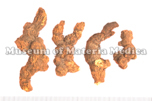Atractylodes Lancea Rhizome

|
Market name:西北蒼朮 Photo location:Museum of Materia Medica, Inst. of Nat. Med. TMPW No.:22483 |

|
Plant name:Atractylodes lancea Photo location:Niigata Pref., Japan Photo date:1988 Photographer:K. Komatsu |
| Synonym | |
| Latin name | Atractylodis Lanceae Rhizoma |
| Botanical source: Family name | Asteraceae (=Compositae) |
| Botanical source: Plant name | - Atractylodes lancea De Candolle (IPNI:182976-1) - Atractylodes chinensis Koidzumi (IPNI:182972-1) - their interspecific hybrids |
| Part used | Rhizome |
| Empirical criteria for quality selection | Good one is enlarged and heavy. It has a strong aroma and taste. (TN) |
| Constituents | Other aliphatic and related compounds: A. lancea: Atractylodinol, Acetylatractylodinol Sesquiterpenoids: A. lancea: Atractylodin, l-α-Bisabolol, β-Selinene, Atractylone, β-Eudesmol, Hinesol, Elemol; A. lancea, A. chinensis: Atractylodin, Hinesol, β-Eudesmol, Elemol, Atractylone, Selina-4(14), 7(11)-dien-8-one |
| Pharmacological effects | Antifungal. Sedative (extract, component of essential oil, β-eudesmol, hinesol). Spasmolytic (extract, β-eudesmol, hinesol). Hypoglycemic (alcohol extract). |
| Indications | As a diuretic, diaphoretic, stomachic and antidiarrheal drug, it is used to treat indigestion, diarrhea and muscle disease due to wind-and-dampness. In Chinese medicine, it is a key medicine for eliminating dampness (disorder of water metabolism). It is better than "Atractylodes Rhizome" in depriving dampness, and is used for warm type of excess syndrome. |
| Diseases | Dyspepsia, Full stomach, Feeling of pressure in the chest, Nausea, Vomitting, Diarrhea, Swelling and pain of joint, Headache, Anhidrosis, Fever, Chill, Night blindness, Corneal opacity, Cataract |
| Formulas | ishoho , ireito , inchingoreisan , eppikajutsuto , eppikajutsubuto , kakkonkajutsubuto , kamikihito , kamishimotsuto , kamishoyosan , kamishoyosankasenkyujio , kamiheiisan , kihito , kyukichoketsuin , kyukichoketsuindaiichikagen , keishieppito , keishikajutsubuto , keishikaryojutsubuto , keishishakuyakuchimoto , keishinieppiittokajutsubu , keishininjinto , keihito , koshaheiisan , koshayoito , kosharikkunshito , goshakusan , goreisan , saishakurikkunshito , saireito , shikunshito , shofusan , shoyosan , shireito , shimbuto , jiinkokato , jiinshihoto , juzentaihoto , jingyobofuto , seishitsuketanto , seishoekkito , seijokentsuto , sokeikakketsuto , daibofuto , jizusoippo , jizusoippokyodaio , teikiin , tokisan , tokishakuyakusan , tokishakuyakusankaogichoto , tokishakuyakusankaninjin , tokishakuyakusankabushi , toryuto , nijutsuto , nyoshinsan , ninjinto , ninjin'yoeito , fukankinshokisan , bukuryoin , bukuryoinkahange , bukuryoingohangekobokuto , bukuryotakushato , bushirichuto , bunshoto , heiisan , hokikenchuto , hochuekkito , boiogito , yokuininto , yokukansan , yokukansankashakuyakuoren , yokukansankachimpihange , rikkunshito , ryokyojutsukanto , ryokeijutsukanto , reitakutsukito , reitakutsukitokashin'i , renjuin |
| Meridian tropism | Spleen, Stomach |
| Property | Warm |
| Flavor | Bitter, Acrid/pungent |
| Classification in "Shen-non Ben-cao Jing" | Superior |
| TCM: Classification | Dampness-resolving drugs with fragrant odor |
| TCM: Medicinal effects | To remove damp and invigorate the function of the spleen, to dispel wind-cold, and to improve eyesight.: For epigastric distention and diarrhea, edema, beriberi, lameness, rheumatic arthralgia, common cold, night blindness. |
| Remarks | Listed in the Japanese Pharmacopoeia 18th ed. |
| References | TN: T. Namba & Y. Tsuda ed., Outline of Pharmacognosy, a Textbook, 3rd ed., Nankodo Co., Ltd., Tokyo, 1998. |
DNA sequences of medicinal plants
| Gene Region | |||||||||||||||||||
| Nuclear | Chloroplast | Mitochondria | |||||||||||||||||
| Botanical source: Plant name | 5Ss | 18S | ITS1 | 5.8S | ITS2 | 26S | others | trnH-psbA | matK | trnK | trnK-rps16 | trnT-L | trnL | trnL-F | rbcL | rpoC1 | ndhF | others | |
|
|
|||||||||||||||||||
|
|
|||||||||||||||||||
|
|
|||||||||||||||||||
